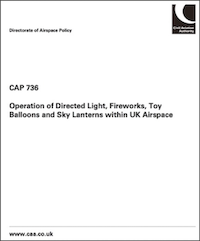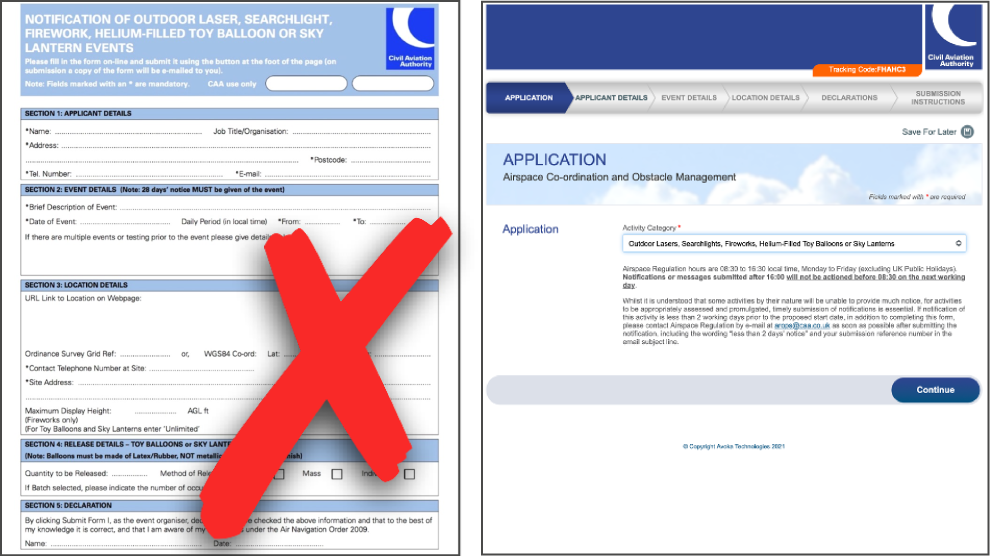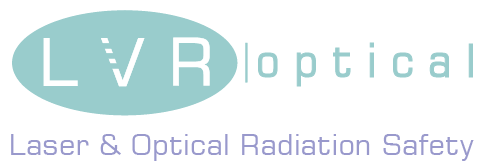
BLOG: Outdoor Laser Use : Update for 2022
Projecting lasers outdoors where the beams may share airspace with other airspace users has to be co-ordinated in the United Kingdom with the Civil Aviation Authority, (the CAA). For many years this has required that laser effects providers complete a single page notification form, known as a DAP 1918, to let the CAA know of the intention to direct laser beams into the sky. The CAA would consider the notification, issue a NOTAM which can be viewed by any interested party, (normally pilots), and where necessary, involve other parties such as aerodromes to make any special organisational arrangements to minimise the chances of aircraft and laser beams using the same airspace simultaneously.
 The CAA have published a document called CAP 736 - Operation of Directed Light, Fireworks, Toy Balloons, and Sky Lanterns within UK Airspace, which sets out the policy for undertaking these activities in a way that will not endanger flight safety.
The CAA have published a document called CAP 736 - Operation of Directed Light, Fireworks, Toy Balloons, and Sky Lanterns within UK Airspace, which sets out the policy for undertaking these activities in a way that will not endanger flight safety.
In 2022 the CAP 736 document remains the same as the original, with the previous update having last been carried out in 2011. However, the method of notifying the CAA has changed. The single page notification form (DAP 1918) that is provided as a sample in Annex A of CAP 736 and was available as a PDF that could be edited on the CAA’s website, has been changed to a more flexible notification system.
The CAA’s original DAP 1918 form was quite straightforward to complete, and for most instances, it just needed to be received by the CAA with a 28-day required notice period, so the laser user could be confident that airspace users had been notified, and the effects could take place without issue. But being a single page form, it was limiting in that only minimal additional space was provided to add extra detail such multiple dates and times, (e.g. for alignment etc., which would often happen at an earlier date to that of the event). The newer submission system that has replaced the DAP 1918 notification addresses such issues and adds new timesaving features.

Applications for laser use outdoors now made under a more general Airspace Co-ordination and Obstacle Management submission process, where the activity category of ‘Outdoor Lasers, Searchlights, Fireworks, Helium-Filled Toy Balloons or Sky Lanterns’ is selected. https://apply.caa.co.uk/CAAPortal
The online process allows the applicant to:
- Specify the display time, and any additional installation or rehearsal times the lasers may be used.
- State if it’s a repeat activity.
- Provision to supply additional information if it’s a more complex install, with multiple lasers.
- Provides an instant acknowledgement of receipt of the application.
- Tracking code, making it possible to log back into the application.
To those familiar with the previous single form approach, the first time you experience the new submission process is quite different. But after you click to accept the terms of usage, the series of screens presented by the web-based submission system are informative and straightforward to follow, and it doesn’t take long to recognise the advantages the new system provides. Particularly with outdoor laser installations growing in complexity, the ability to upload extra detail and maps on this kind of scenario is really useful in providing the CAA with a fuller picture.
Another welcome change is that, officially now, the notification period has been reduced from 28 days to 7 days.
One final point to keep in mind though, (as it’s something that we all too often see confusion over), is that just because an airspace co-ordination submission for lasers has taken place and there have been no objections or concerns raised, the responsibility still exists with the laser operator to ensure that laser effects do not cause a distraction to aircraft operations. The Air Navigational Order (ANO) 2009 and Laser Misuse (Vehicles) Act 2018 both provide means to which someone allowing laser beams to interfere with flight safety can be prosecuted. Therefore, laser effects use outdoors need to be supervised, with spotters able to monitor the skyward beam paths, making sure no aircraft are present. e.g. in a common situation outdoors, where the laser operator is controlling effects from in front of a festival stage, in an enclosed FOH mix position tent, an additional spotter is required to see what is happening where the beams are projecting in the sky. It’s not sufficient to just rely on the operator who can only see ahead to the stage.
Just because a submission is made, doesn’t mean concerns can be dropped about what aircraft could be present in the beam paths. The submission is just part of the process, informing about intended laser effects use. The responsibility to use the effects safely still remains with the laser operator.
© April 2022 LVR Optical
